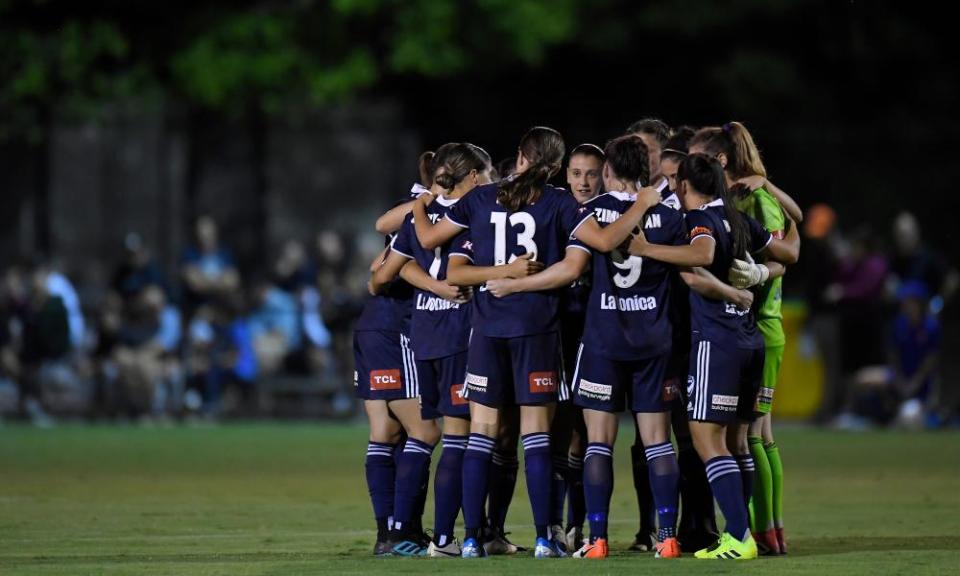Broadcasting bungles undermine genuine quality of W-League

It is the 10th minute of Brisbane Roar’s round five match against Melbourne Victory. On the far side of the field, two of the league’s most exciting players – young Australian full-back Angie Beard and Brazilian winger Mariel Hecher – tussle for possession, matching each other stride for stride.
Hecher comes away from the tussle with the ball at her feet. She charges towards the box and takes a shot that clatters off a Victory defender and is thumped away upfield. Broadcast co-commentator Amy Chapman, a former Roar and Matildas player, narrates through the pause as both teams reset and prepare to go again.
Related: W-League's culture placed under threat after men throw bottles onto pitch | Samantha Lewis
“That’ll be a match-up to watch tonight, Angie Beard and Mariel Hecher,” she says, “both very aggressive players and both very passionate players and both have a lot of speed, so it’ll be interesting to see who comes out on top there.”
If only we could. Moments later, the livestream showing the match went completely dark. The audio feed dropped out, as did all the game’s graphics, including the scoreboard and the game clock. The only thing visible on the screen for several seconds was the Fox Sports logo, sitting starkly alongside what has now become their deeply ironic motto: “Every moment counts.”
Not every moment, it seems. This is not the first time that Australian football’s main broadcaster has come under fire for poor-quality productions, glitches, or feed drop-outs this season. In the A-League in early January, a Wellington Phoenix equaliser against Sydney FC was missed entirely by television audiences after the screen spluttered to black, with only Brenton Speed’s excited commentary providing information about the goal itself.
That same weekend, the W-League’s game between Canberra United and Melbourne City – which was also simulcast on ABC, the nations’ biggest public broadcaster – was interrupted by a large hexagonal graphic that floated in the middle of the screen, obscuring most of the field for several minutes.
It is no secret the relationship between Fox Sports and Australia’s professional leagues has deteriorated in recent years, resulting in a noticeable drop-off in broadcast quality. The number of cameras across both leagues has been reduced, preview and review shows have disappeared, and many of the game’s most recognisable faces and voices have walked out the door, giving both competitions a shoestring look and feel when they do go to air.

Saturday night’s game between Brisbane and Victory was a case in point. Blackout aside, the game was filmed with a single non-HD camera on a poorly-lit pitch, while instant replays and half-time analysis were nowhere to be found. “Coverage of the W-League needs to be better,” PFA co-chief executive Kate Gill tweeted shortly after full-time. “Tonight’s game is a great example – no replays, no crowd noise, lost audio, poor production quality. The game, the players and the fans deserve [better].”
This is a worrying trend given that sport is increasingly consumed through television and online streaming, meaning the ways in which competitions are packaged and presented to audiences at home has never been more important for their survival – especially during the pandemic.
It is particularly worrying for the W-League which, like many women’s sports leagues, still relies almost entirely upon mainstream broadcast coverage to continue building its fan base and grow its commercial appeal. This is a startling amount of power and responsibility to give a company that, despite being the main broadcast partner of the W-League, Did not include any of its players or even its logo in the Foxtel advertisement they hurriedly aired during Saturday night’s feed drop-out, further confirming its afterthought status.
These neglectful decisions affect more than just fans watching at home. With the exception of contracted Matildas, most W-League players are semi-professional athletes who depend upon the platform offered by the competition to not only be recognised by national team selectors, but also potentially identified by clubs overseas that could offer them longer, more secure careers. Quality broadcast coverage, then, does not just mean a more appealing product for fans or a crisper billboard for advertisers; it can fundamentally affect the livelihoods of Australia’s best footballers.
With the 2023 Women’s World Cup on the horizon, Fox Sports’ continued sub-standard treatment of the W-League sends an alarming message to Fifa and the world about how Australia values its top-tier women’s competition. It also provides yet more evidence that the newly-unbundled professional clubs should look elsewhere for a broadcast partner (or partners) that believe in the same power and potential of the competitions as they do. The W-League is an exciting, evolving product that is home to some of the most talented athletes in Australian sport – its clubs must find a broadcaster who will treat it that way.

 Yahoo Finance
Yahoo Finance 